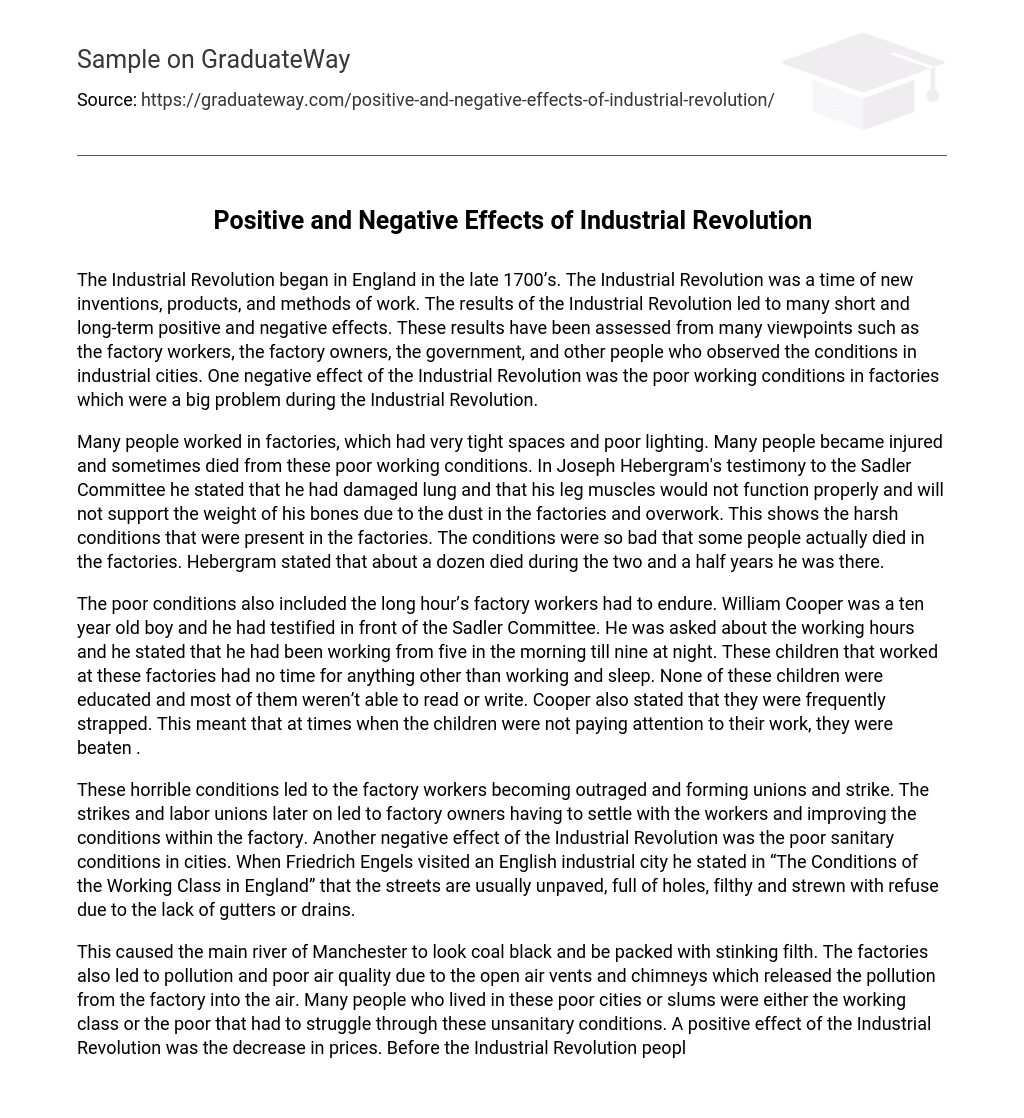The Industrial Revolution started in England in the late 1700’s and brought about new inventions, products, and work methods. It had both positive and negative effects, which were evaluated by various stakeholders including factory workers, owners, the government, and observers of industrial cities. Among the negative impacts was the significant issue of poor working conditions in factories during this period.
Many people faced harsh working conditions in factories, characterized by cramped spaces and inadequate lighting. These conditions resulted in numerous injuries and even fatalities. In his testimony to the Sadler Committee, Joseph Hebergram revealed that he suffered from damaged lungs and impaired leg muscles, which rendered them incapable of bearing the weight of his bones. He attributed these health issues to the combination of dust present in the factories and excessive work demands. Hebergram’s account serves as evidence of the severe conditions that prevailed in the factories, where some individuals tragically lost their lives. According to Hebergram, approximately twelve deaths occurred during his two and a half years of employment in the factories.
The factories had poor conditions, with factory workers facing long working hours. William Cooper, a ten-year-old boy, testified about his experience before the Sadler Committee. He disclosed that he worked from five in the morning until nine at night. These young factory workers had no time for anything except work and sleep. They lacked education and basic literacy skills. Cooper also mentioned that they were frequently punished, often beaten, when they failed to concentrate on their work.
The terrible conditions caused the factory workers to become angry and create unions and go on strike. These strikes and labor unions eventually forced factory owners to reach agreements with the workers and make improvements to the conditions in the factories. Another negative consequence of the Industrial Revolution was the unsanitary state of cities. When Friedrich Engels visited an English industrial city, he described in his work “The Conditions of the Working Class in England” that the streets were typically unpaved, full of holes, dirty, and covered in garbage because there were no gutters or drains.
The environment suffered negative consequences as a result of the Industrial Revolution, especially in Manchester. The city’s main river became heavily polluted and dirty, taking on a coal black color due to the waste that was dumped into it. Moreover, factories contributed to air pollution and deteriorating air quality through their open air vents and chimneys, which released pollutants into the atmosphere. The people living in these impoverished areas, predominantly occupied by the working class and poor individuals, had to endure these unhygienic living conditions. However, there was one positive outcome from the Industrial Revolution: prices decreased. Prior to this era, individuals mainly worked out of their homes or small workshops, resulting in higher costs for handmade goods.
In earlier times, people typically only owned one shirt and one pair of pants. However, as the demand for more goods increased in the 1700s, textile traders began looking for faster and more cost-effective ways to produce clothing. Machines like the spinning jenny, which could spin eight threads simultaneously; the flying shuttle that improved weaving speed; and the water frame – a large spinning machine powered by water in factories – played a role in achieving lower prices.
The improvements made are acknowledged by the author of “The Working Man’s Companion”: “Your houses are better constructed, your clothes are less expensive, and you have an endless array of household utensils.”
During the Industrial Revolution, the prices of goods decreased significantly, resulting in improved living conditions for people in the long run. Additionally, there was a substantial increase in iron production between 1740 and 1900 as a positive consequence of this revolution. Initially, only 17,350 tons of iron were produced by the British in 1740. However, the production quantity underwent a massive surge afterwards. By 1796, more than 100,000 tons had been produced; by 1839, over one million tons; by 1854, over three million tons; and by 1900, an astonishing nine million tons of iron had been produced. This clearly showcases how the Industrial Revolution greatly stimulated iron production.
During the time trains were being constructed, the production of iron played a crucial role in improving transportation and facilitating the movement of goods. Additionally, certain factories saw improvements in working conditions. In “The Philosophy of Manufacturers,” Andrew Ure observed that the children working in these factories appeared to be consistently happy and energetic, even skipping on their way home. These observations suggest that the factory owners treated the children well and implemented regulations to prevent mistreatment.
The Society for Bettering the Condition and Increasing the Comforts of the Poor published a pamphlet mentioning that children working at Mr. Dale’s factory had a healthy appearance that caught the attention of travelers. This was credited to the regulations implemented by Mr. Dale, which differed from those followed in other factories. Between 1785 and 1797, out of the 3000 employed children, only 14 had died, while other factories saw numerous annual fatalities due to machine accidents. In “Manchester in 1844,” Leon Faucher stated that Mr. Ashton greatly benefited Hyde town, initially with a population of 800 people.
With a workforce of 1500 in his factories, Ashton had a positive influence on Hyde city. In essence, the Industrial Revolution resulted in both favorable and unfavorable consequences for society. Similar to the French Revolution, it had a lasting impact on society and elevated the middle class’s status. Despite causing ongoing negative social and economic problems, it also played a role in England’s emergence as a global power. Hence, the Industrial Revolution remains acknowledged as one of history’s notable events.





